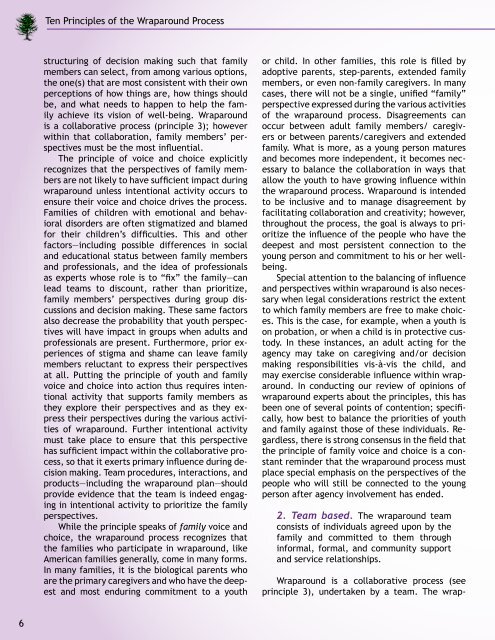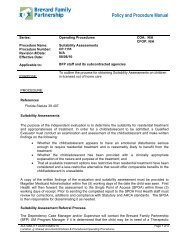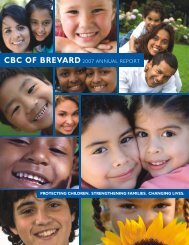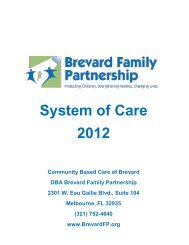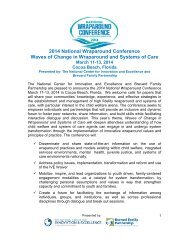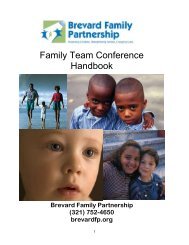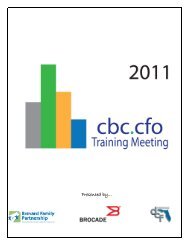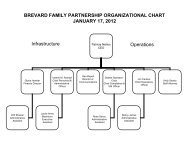10 Principles of the Wraparound Process
10 Principles of the Wraparound Process
10 Principles of the Wraparound Process
Create successful ePaper yourself
Turn your PDF publications into a flip-book with our unique Google optimized e-Paper software.
Ten <strong>Principles</strong> <strong>of</strong> <strong>the</strong> <strong>Wraparound</strong> <strong>Process</strong>structuring <strong>of</strong> decision making such that familymembers can select, from among various options,<strong>the</strong> one(s) that are most consistent with <strong>the</strong>ir ownperceptions <strong>of</strong> how things are, how things shouldbe, and what needs to happen to help <strong>the</strong> familyachieve its vision <strong>of</strong> well-being. <strong>Wraparound</strong>is a collaborative process (principle 3); howeverwithin that collaboration, family members’ perspectivesmust be <strong>the</strong> most influential.The principle <strong>of</strong> voice and choice explicitlyrecognizes that <strong>the</strong> perspectives <strong>of</strong> family membersare not likely to have sufficient impact duringwraparound unless intentional activity occurs toensure <strong>the</strong>ir voice and choice drives <strong>the</strong> process.Families <strong>of</strong> children with emotional and behavioraldisorders are <strong>of</strong>ten stigmatized and blamedfor <strong>the</strong>ir children’s difficulties. This and o<strong>the</strong>rfactors—including possible differences in socialand educational status between family membersand pr<strong>of</strong>essionals, and <strong>the</strong> idea <strong>of</strong> pr<strong>of</strong>essionalsas experts whose role is to “fix” <strong>the</strong> family—canlead teams to discount, ra<strong>the</strong>r than prioritize,family members’ perspectives during group discussionsand decision making. These same factorsalso decrease <strong>the</strong> probability that youth perspectiveswill have impact in groups when adults andpr<strong>of</strong>essionals are present. Fur<strong>the</strong>rmore, prior experiences<strong>of</strong> stigma and shame can leave familymembers reluctant to express <strong>the</strong>ir perspectivesat all. Putting <strong>the</strong> principle <strong>of</strong> youth and familyvoice and choice into action thus requires intentionalactivity that supports family members as<strong>the</strong>y explore <strong>the</strong>ir perspectives and as <strong>the</strong>y express<strong>the</strong>ir perspectives during <strong>the</strong> various activities<strong>of</strong> wraparound. Fur<strong>the</strong>r intentional activitymust take place to ensure that this perspectivehas sufficient impact within <strong>the</strong> collaborative process,so that it exerts primary influence during decisionmaking. Team procedures, interactions, andproducts—including <strong>the</strong> wraparound plan—shouldprovide evidence that <strong>the</strong> team is indeed engagingin intentional activity to prioritize <strong>the</strong> familyperspectives.While <strong>the</strong> principle speaks <strong>of</strong> family voice andchoice, <strong>the</strong> wraparound process recognizes that<strong>the</strong> families who participate in wraparound, likeAmerican families generally, come in many forms.In many families, it is <strong>the</strong> biological parents whoare <strong>the</strong> primary caregivers and who have <strong>the</strong> deepestand most enduring commitment to a youthor child. In o<strong>the</strong>r families, this role is filled byadoptive parents, step-parents, extended familymembers, or even non-family caregivers. In manycases, <strong>the</strong>re will not be a single, unified “family”perspective expressed during <strong>the</strong> various activities<strong>of</strong> <strong>the</strong> wraparound process. Disagreements canoccur between adult family members/ caregiversor between parents/caregivers and extendedfamily. What is more, as a young person maturesand becomes more independent, it becomes necessaryto balance <strong>the</strong> collaboration in ways thatallow <strong>the</strong> youth to have growing influence within<strong>the</strong> wraparound process. <strong>Wraparound</strong> is intendedto be inclusive and to manage disagreement byfacilitating collaboration and creativity; however,throughout <strong>the</strong> process, <strong>the</strong> goal is always to prioritize<strong>the</strong> influence <strong>of</strong> <strong>the</strong> people who have <strong>the</strong>deepest and most persistent connection to <strong>the</strong>young person and commitment to his or her wellbeing.Special attention to <strong>the</strong> balancing <strong>of</strong> influenceand perspectives within wraparound is also necessarywhen legal considerations restrict <strong>the</strong> extentto which family members are free to make choices.This is <strong>the</strong> case, for example, when a youth ison probation, or when a child is in protective custody.In <strong>the</strong>se instances, an adult acting for <strong>the</strong>agency may take on caregiving and/or decisionmaking responsibilities vis-à-vis <strong>the</strong> child, andmay exercise considerable influence within wraparound.In conducting our review <strong>of</strong> opinions <strong>of</strong>wraparound experts about <strong>the</strong> principles, this hasbeen one <strong>of</strong> several points <strong>of</strong> contention; specifically,how best to balance <strong>the</strong> priorities <strong>of</strong> youthand family against those <strong>of</strong> <strong>the</strong>se individuals. Regardless,<strong>the</strong>re is strong consensus in <strong>the</strong> field that<strong>the</strong> principle <strong>of</strong> family voice and choice is a constantreminder that <strong>the</strong> wraparound process mustplace special emphasis on <strong>the</strong> perspectives <strong>of</strong> <strong>the</strong>people who will still be connected to <strong>the</strong> youngperson after agency involvement has ended.2. Team based. The wraparound teamconsists <strong>of</strong> individuals agreed upon by <strong>the</strong>family and committed to <strong>the</strong>m throughinformal, formal, and community supportand service relationships.<strong>Wraparound</strong> is a collaborative process (seeprinciple 3), undertaken by a team. The wrap-


